Ultrasonic Welding of Aluminum to Steel: A Review
Abstract
:1. Introduction
2. Introduction of USW
2.1. Principle and Characteristics of USW
2.2. Advantages of USW
- (1).
- (2).
- No water cooling or shielding gas, surface cleaning, and the addition of filler materials are required. Moreover, USW is insensitive to surface oxide film [16].
- (3).
- (4).
- (5).
- (6).
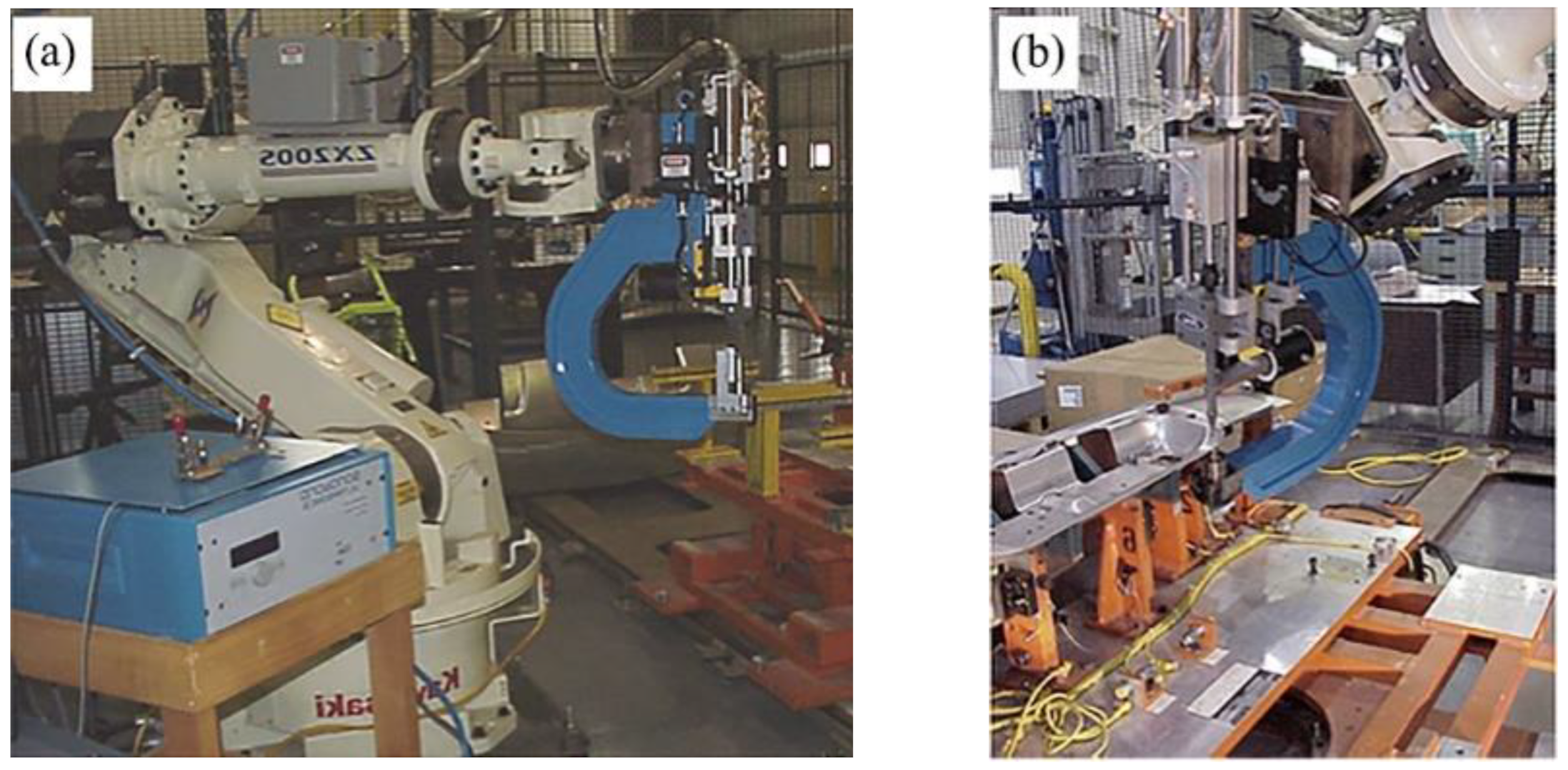
2.3. System of Aluminum-to-Steel USW
3. Status of Experimental Research on Aluminum to Steel USW
3.1. Interface Temperature of Aluminum to Steel USW
3.2. Plastic Deformation of Aluminum to Steel USW
3.3. Microstructure of Aluminum-to-Steel USW
3.3.1. Interfacial Diffusion
3.3.2. IMC Formation Mechanism
3.3.3. Recrystallization Microstructure
3.4. Strength and Failure of Aluminum-to-Steel Ultrasonic Welded Joint
3.5. Fatigue Strength of Aluminum-to-Steel Ultrasonic Welded Joint
4. Modeling of Aluminum-to-Steel USW
5. New Application of Aluminum-to-Steel USW
5.1. Perpendicular Ultrasonic Welding Technology
5.2. Multi-Spot Ultrasonic Welding Technology
6. Conclusions and Future Perspectives
- (1).
- The steel specimens in USWed aluminum-to-steel are mainly using low-carbon steel, low-carbon galvanized steel, and SS304 stainless steel. In the future, other welding heat sources, such as RSW and LW, can be combined with aluminum alloy and high-strength steel USW to obtain high-quality joining.
- (2).
- During the USW process of aluminum and steel, the interface temperature and IMC layer thickness increased with the vibration amplitude. The welding quality gradually improved with increased clamping force, but excessive clamping force can result in cracks and other defects in the workpiece. The IMC layer thickness increased, and its composition changed with an increase in the welding time. There are very few reports to date on the parametric optimization of the aluminum-to-steel USW for improving the joint quality. Optimizing the tool head geometry and welding parameters of aluminum-to-steel USW is a research direction in the future.
- (3).
- The investigation of the USW process by the finite element method was mainly conducted to reveal the macro interface temperature increase and plastic deformation mechanism. In the future, the simulation of nano-scale plastic deformation of the welding interface and ultrasound field distribution in the specimens will help further reveal the welding mechanism of USW. In addition, molecular dynamics simulation of diffusion and atomic migration of the welding interface is a significant research direction.
- (4).
- In the USW process of aluminum-to-steel, the main IMCs produced by diffusion are Fe2Al5, FeAl3, and FeAl at the aluminum-to-steel interface, which are all brittle IMC. For USW of aluminum alloy and galvanized sheet, the coating on the galvanized steel surface will prevent the atom diffusion between Fe and Al. Consequently, the growth mechanism of predicting and controlling IMC by simulation represents a significant research direction. In addition, deformation and welding defects easily occur since the steel has large stiffness. In the future, controlling the shape and microstructure can improve the quality of aluminum-to-steel USW.
Author Contributions
Funding
Institutional Review Board Statement
Informed Consent Statement
Data Availability Statement
Conflicts of Interest
References
- Baek, S.; Go, G.Y.; Park, J.W.; Song, J.; Lee, H.C.; Lee, S.J.; Lee, S.; Chen, C.; Kim, M.S.; Kim, D. Microstructural and interface geometrical influence on the mechanical fatigue property of aluminum/high-strength steel lap joints using resistance element welding for lightweight vehicles: Experimental and computational investigation. J. Mater. Res. Technol. 2022, 17, 658–678. [Google Scholar] [CrossRef]
- Wu, C.S.; Lu, X.Q.; Su, H.; Shi, L. Research progress in dissimilar friction stir welding of aluminium/magnesium alloys. J. Mech. Eng. 2020, 56, 4–16. (In Chinese) [Google Scholar]
- Haddadi, F. Microstructure reaction control of dissimilar automotive aluminium to galvanized steel sheets ultrasonic spot welding. Mater. Sci. Eng. A 2016, 678, 72–84. [Google Scholar] [CrossRef]
- Wang, T.; Sinha, S.; Komarasamy, M.; Shukla, S.; Williams, S.; Mishra, R.S. Ultrasonic spot welding of dissimilar Al 6022 and Al 7075 alloys. J. Mater. Process. Technol. 2020, 278, 116460. [Google Scholar] [CrossRef]
- Macwan, A.; Kumar, A.; Chen, D.L. Ultrasonic spot welded 6111-T4 aluminum alloy to galvanized high-strength low-alloy steel: Microstructure and mechanical properties. Mater. Des. 2017, 113, 284–296. [Google Scholar] [CrossRef]
- Matsuda, T.; Ogaki, T.; Hayashi, K.; Iwamoto, C.; Nozawa, T.; Ohata, M.; Hirose, A. Fracture dominant in friction stir spot welded joint between 6061 aluminum alloy and galvannealed steel based on microscale tensile testing. Mater. Des. 2022, 213, 110344. [Google Scholar] [CrossRef]
- Zhao, Y.Q.; Zhao, Y.J.; Liu, Z.; Lin, Z.C.; Dong, C.L. Control of temperature field, microstructure and mechanical properties of variable rotation speed refill friction stir spot welded high strength aluminum alloys. Trans. China Weld. Inst. 2022, 43, 50–55. (In Chinese) [Google Scholar]
- Ling, Z.X.; Li, Y.; Luo, Z.; Feng, Y.Q.; Wang, Z.M. Resistance element welding of 6061 aluminum alloy to uncoated 22MnMoB boron steel. Mater. Manuf. Process. 2016, 31, 2174–2180. [Google Scholar] [CrossRef]
- He, G.Z.; Lou, M.; Ma, Y.W.; Li, Y.B. Simulation on mechanical properties of resistance element welding of aluminum and steel. J. Shanghai Jiao Tong Univ. 2019, 53, 616–623. (In Chinese) [Google Scholar]
- Wang, X.H.; Gu, X.Y.; Sun, D.Q. Research on interface characteristic of laser welding joints of steel/aluminum dissimilar materials. J. Mech. Eng. 2017, 53, 26–33. (In Chinese) [Google Scholar] [CrossRef]
- Shin, S.; Nam, S.; Yu, J.; Park, J.; Kim, D. Ultrasonic metal welding of multilayered copper foils to nickel-plated copper sheet in lithium-ion battery cell. Metals 2021, 11, 1195. [Google Scholar] [CrossRef]
- Feng, M.N.; Luo, Z. Interface morphology and microstructure of high-power ultrasonic spot welded Mg/Al dissimilar joint. Sci. Technol. Weld. Join. 2018, 24, 63–78. [Google Scholar] [CrossRef]
- Gullino, A.; Matteis, P.; D’Aiuto, F. Review of aluminum-to-steel welding technologies for car-body applications. Metals 2019, 9, 315. [Google Scholar] [CrossRef]
- Zhou, L.; Liu, S.; Min, J.; Qin, Z.W.; He, W.X.; Song, X.G.; Xu, H.B.; Feng, J.C. Interface microstructure and formation mechanism of ultrasonic spot welding for Al–Ti dissimilar metals. Int. J. Min. Met. Mater. 2021, 28, 1506–1514. [Google Scholar] [CrossRef]
- Sun, Y.M.; Gong, W.B.; Feng, J.C.; Lu, G.P.; Zhu, R.; Li, Y.P. A review of the friction stir welding of dissimilar materials between aluminum alloys and copper. Metals 2022, 12, 675. [Google Scholar] [CrossRef]
- Cai, W.; Daehn, G.; Vivek, A.; Li, J.; Khan, H.; Mishra, R.S.; Komarasamy, M. A state-of-the-art review on solid-state metal joining. J. Manuf. Sci. Eng. 2019, 141, 031012. [Google Scholar] [CrossRef]
- Ao, S.S.; Zhang, W.; Li, C.J.; Oliveira, J.P.; Zeng, Z.; Luo, Z. Variable-parameter NiTi ultrasonic spot welding with Cu interlayer. Mater. Manuf. Process. 2020, 36, 599–607. [Google Scholar] [CrossRef]
- Li, H.; Zhou, K.; Cao, B.; Zhang, J. Analysis of welding interface and joint properties of high power ultrasonic welding of aluminum alloy. J. Mech. Eng. 2021, 57, 87–95. (In Chinese) [Google Scholar]
- Ni, Z.L.; Yang, J.J.; Ye, F.X. Microstructure and mechanical properties of copper to nickel ultrasonic spot welds. Mater. Sci. Eng. A 2020, 796, 140207. [Google Scholar] [CrossRef]
- Ma, Q.C.; Ma, J.Y.; Zhou, J.L.; Ji, H.J. Intrinsic dependence of welding quality and recrystallization on the surface-contacted micro-asperity scale during ultrasonic welding of Cu–Cu joints. J. Mater. Res. Technol. 2022, 17, 353–364. [Google Scholar] [CrossRef]
- Lin, J.Y.; Nambu, S.; Koseki, T. Evolution of bonding interface during ultrasonic welding between steel and aluminium alloy. Sci. Technol. Weld. Join. 2019, 24, 83–91. [Google Scholar] [CrossRef]
- Satpathy, M.P.; Patel, B.; Sahoo, S.K. Exploration of bonding phenomenon and microstructural characterization during high-power ultrasonic spot welding of aluminum to steel sheets with copper interlayer. Ain Shams Eng. J. 2019, 10, 811–819. [Google Scholar] [CrossRef]
- Li, H.; Cao, B. Effects of welding pressure on high-power ultrasonic spot welding of Cu/Al dissimilar metals. J. Manuf. Process. 2019, 46, 194–203. [Google Scholar] [CrossRef]
- Zhang, C.; Li, L. A friction-based finite element analysis of ultrasonic consolidation. Weld. J. 2008, 87, 187–194. [Google Scholar]
- Komiyama, K.; Sasaki, T.; Watanabe, Y. Effect of tool edge geometry in ultrasonic welding. J. Mater. Process. Technol. 2016, 229, 714–721. [Google Scholar] [CrossRef]
- Lee, D.; Cai, W. The effect of horn knurl geometry on battery tab ultrasonic welding quality: 2D finite element simulations. J. Manuf. Process. 2017, 28, 428–441. [Google Scholar] [CrossRef]
- Mukhametgalina, A.A.; Murzinova, M.A.; Nazarov, A.A. Weld quality and microstructure development in ultrasonically welded titanium joints. Metall. Mater. Trans. A 2022, 53, 1119–1131. [Google Scholar] [CrossRef]
- Macwan, A. Ultrasonic Spot Welding of Similar and Dissimilar Alloys for Automotive Applications. Ph.D. Thesis, Ryerson University, Toronto, ON, Canada, 2016. [Google Scholar]
- Rubino, F.; Parmar, H.; Esperto, V.; Carlone, P. Ultrasonic welding of magnesium alloys: A review. Mater. Manuf. Process. 2020, 35, 1051–1068. [Google Scholar] [CrossRef]
- De Leon, M.; Shin, H.S. Review of the advancements in aluminum and copper ultrasonic welding in electric vehicles and superconductor applications. J. Mater. Process. Technol. 2022, 307, 117691. [Google Scholar] [CrossRef]
- Haddadi, F. Rapid intermetallic growth under high strain rate deformation during high power ultrasonic spot welding of aluminium to steel. Mater. Des. 2015, 66, 459–472. [Google Scholar] [CrossRef]
- Haddadi, F.; Abu-Farha, F. Microstructural and mechanical performance of aluminium to steel high power ultrasonic spot welding. J. Mater. Process. Technol. 2015, 225, 262–274. [Google Scholar] [CrossRef]
- Haddadi, F.; Strong, D.; Prangnell, P.B. Effect of zinc coatings on joint properties and interfacial reactions in aluminum to steel ultrasonic spot welding. JOM 2012, 64, 407–413. [Google Scholar] [CrossRef]
- Wang, T.; Shukla, S.; Frank, M.; Mishra, R.S. Evolution of bond formation and fracture process of ultrasonic spot welded dissimilar materials. Sci. Technol. Weld. Join. 2019, 24, 171–177. [Google Scholar] [CrossRef]
- Haddadi, F.; Abu-Farha, F. The effect of interface reaction on vibration evolution and performance of aluminium to steel high power ultrasonic spot joints. Mater. Des. 2016, 89, 50–57. [Google Scholar] [CrossRef]
- Patel, V.K.; Bhole, S.D.; Chen, D.L. Ultrasonic spot welding of aluminum to high-strength low-alloy steel: Microstructure, tensile and fatigue properties. Metall. Mater. Trans. A 2014, 45, 2055–2066. [Google Scholar] [CrossRef]
- Macwan, A.; Jiang, X.Q.; Chen, D.L. Interfacial characterization of dissimilar joints between Al/Mg/Al-trilayered clad sheet to high-strength low-alloy steel. JOM 2015, 67, 1468–1477. [Google Scholar] [CrossRef]
- Mirza, F.A.; Macwan, A.; Bhole, S.D.; Chen, D.L.; Chen, X.G. Microstructure, tensile and fatigue properties of ultrasonic spot welded aluminum to galvanized high-strength-low-alloy and low-carbon steel sheets. Mater. Sci. Eng. A 2017, 690, 323–336. [Google Scholar] [CrossRef]
- Gunduz, I.; Ando, T.; Shattuck, E.; Wong, P.; Doumanidis, C. Enhanced diffusion and phase transformations during ultrasonic welding of zinc and aluminum. Scr. Mater. 2005, 52, 939–943. [Google Scholar] [CrossRef]
- Shakil, M.; Tariq, N.H.; Ahmad, M.; Choudhary, M.A.; Akhter, J.I.; Babu, S.S. Effect of ultrasonic welding parameters on microstructure and mechanical properties of dissimilar joints. Mater. Des. 2014, 55, 263–273. [Google Scholar] [CrossRef]
- Watanabe, T.; Sakuyama, H.; Yanagisawa, A. Ultrasonic welding between mild steel sheet and Al–Mg alloy sheet. J. Mater. Process. Technol. 2009, 209, 5475–5480. [Google Scholar] [CrossRef]
- Prangnell, P.; Haddadi, F.; Chen, Y.C. Ultrasonic spot welding of aluminium to steel for automotive applications—Microstructure and optimisation. Mater. Sci. Technol. 2011, 27, 617–624. [Google Scholar] [CrossRef]
- Mirza, F.A.; Macwan, A.; Bhole, S.D.; Chen, D.L.; Chen, X.G. Effect of welding energy on microstructure and strength of ultrasonic spot welded dissimilar joints of aluminum to steel sheets. Mater. Sci. Eng. A 2016, 668, 73–85. [Google Scholar] [CrossRef]
- Xu, L.; Wang, L.; Chen, Y.-C.; Robson, J.D.; Prangnell, P.B. Effect of interfacial reaction on the mechanical performance of steel to aluminum dissimilar ultrasonic spot welds. Metall. Mater. Trans. A 2015, 47, 334–346. [Google Scholar] [CrossRef] [Green Version]
- Fujii, H.T.; Goto, Y.; Sato, Y.S.; Kokawa, H. Microstructure and lap shear strength of the weld interface in ultrasonic welding of Al alloy to stainless steel. Scr. Mater. 2016, 116, 135–138. [Google Scholar] [CrossRef]
- Becker, M.; Balle, F. Multi-spot ultrasonic welding of aluminum to steel sheets: Process and fracture analysis. Metals 2021, 11, 779. [Google Scholar] [CrossRef]
- Tsujino, J.; Hidai, K.; Hasegawa, A.; Kanai, R.; Matsuura, H.; Matsushima, K.; Ueoka, T. Ultrasonic butt welding of aluminum, aluminum alloy and stainless steel plate specimens. Ultrasonics 2002, 40, 371–374. [Google Scholar] [CrossRef]
- Zhao, D.W.; Ren, D.X.; Zhao, K.M.; Pan, S.; Guo, X. Effect of welding parameters on tensile strength of ultrasonic spot welded joints of aluminum to steel—By experimentation and artificial neural network. J. Manuf. Process. 2017, 30, 63–74. [Google Scholar] [CrossRef]
- Nishihara, K.; Watanabe, T.; Sasaki, T. Effect of weld tip geometry on ultrasonic welding between steel and aluminum alloy. Adv. Mat. Res. 2010, 89–91, 419–424. [Google Scholar] [CrossRef]
- Satpathy, M.P.; Sahoo, S.K. Mechanical performance and metallurgical characterization of ultrasonically welded dissimilar joints. J. Manuf. Process. 2017, 25, 443–451. [Google Scholar] [CrossRef]
- Jedrasiak, P.; Shercliff, H.R.; Chen, Y.C.; Wang, L.; Prangnell, P.; Robson, J. Modeling of the thermal field in dissimilar alloy ultrasonic welding. J. Mater. Eng. Perform. 2015, 24, 799–807. [Google Scholar] [CrossRef] [Green Version]
- Jedrasiak, P.; Shercliff, H.R. Finite element analysis of heat generation in dissimilar alloy ultrasonic welding. Mater. Des. 2018, 158, 184–197. [Google Scholar] [CrossRef]
- Munoz-Guijosa, J.M.; Nanaumi, G.; Ohtani, K.; Ohtake, N. Perpendicular ultrasonic joining of steel to aluminium alloy plates. J. Mater. Process. Technol. 2017, 243, 112–122. [Google Scholar] [CrossRef]

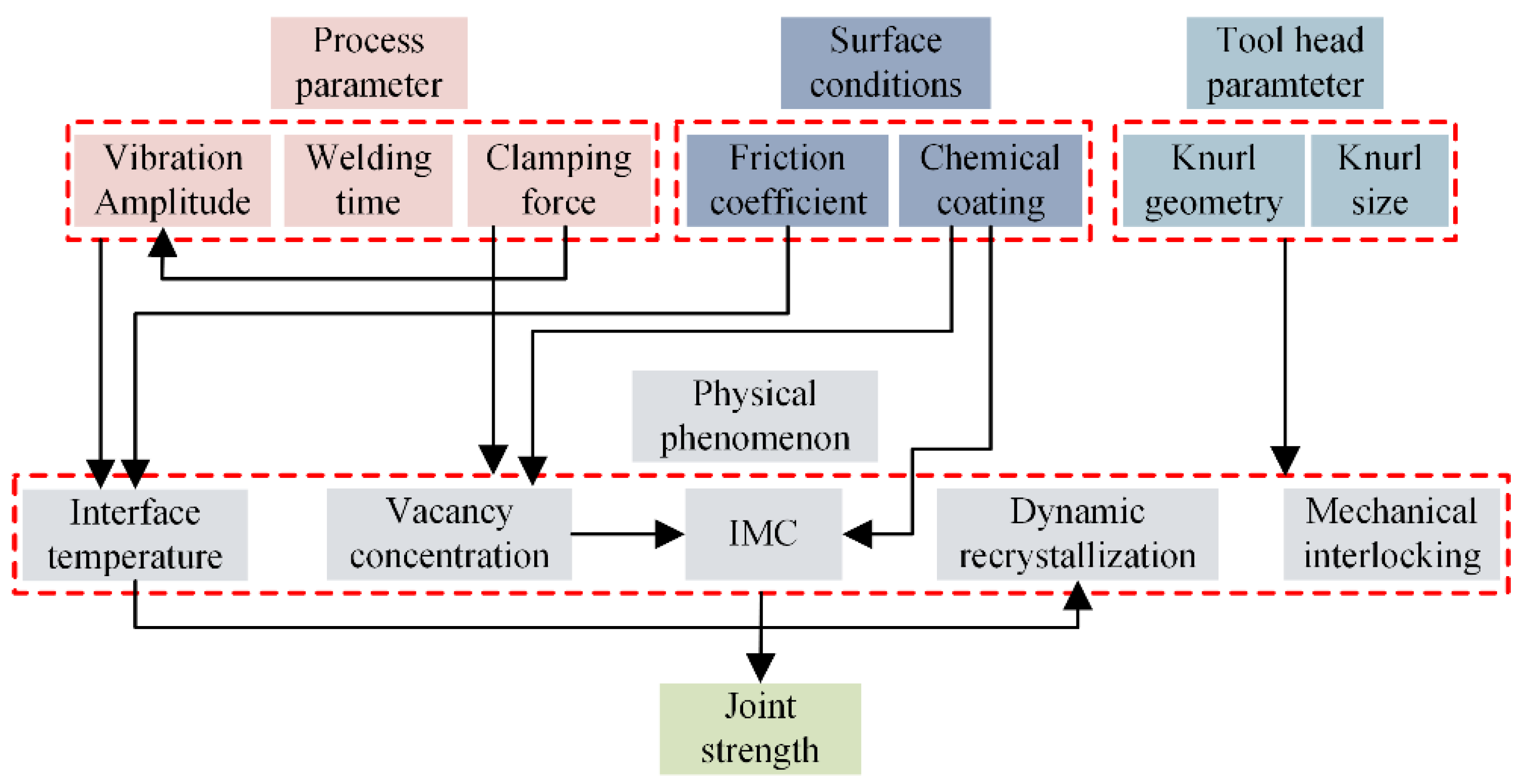
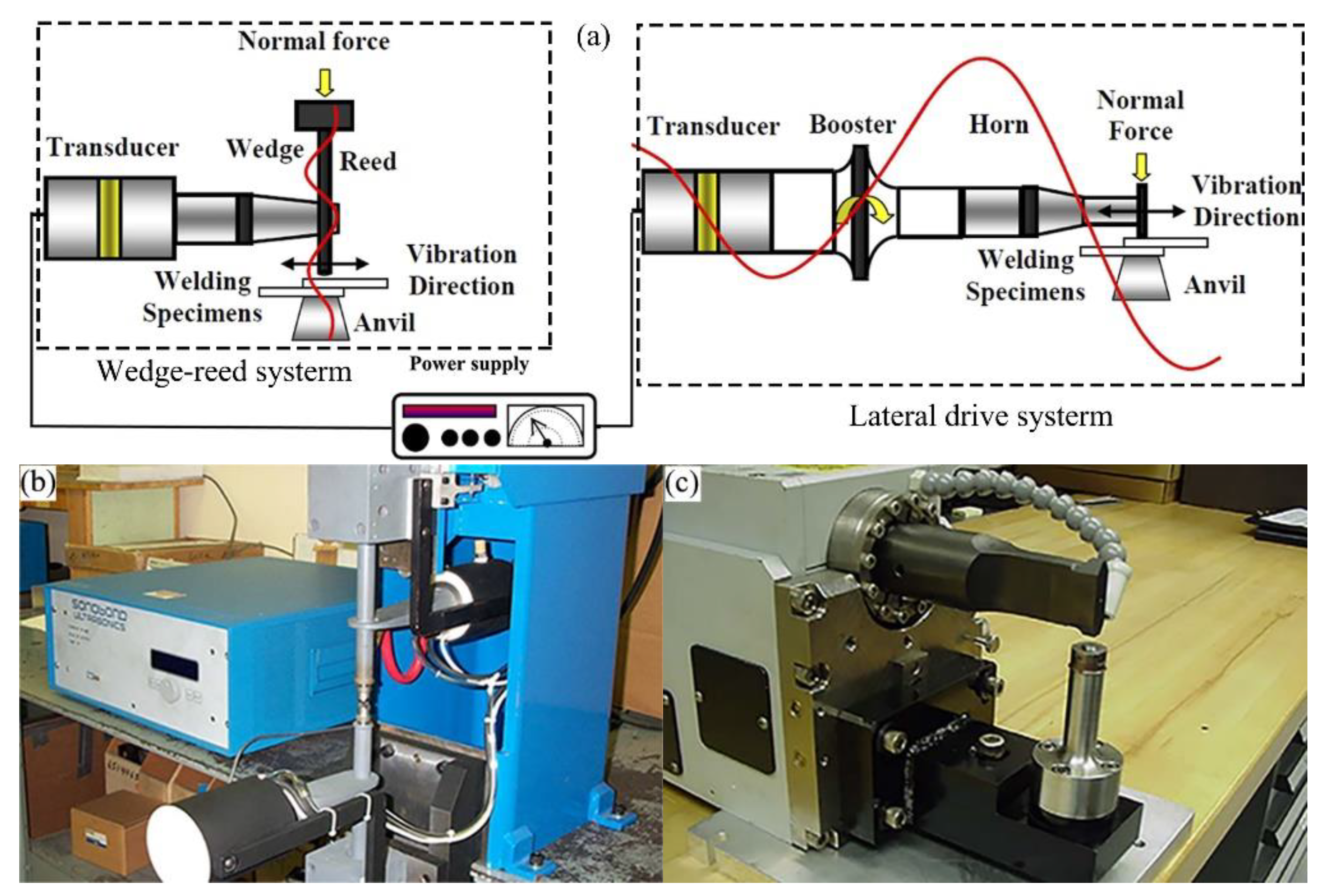

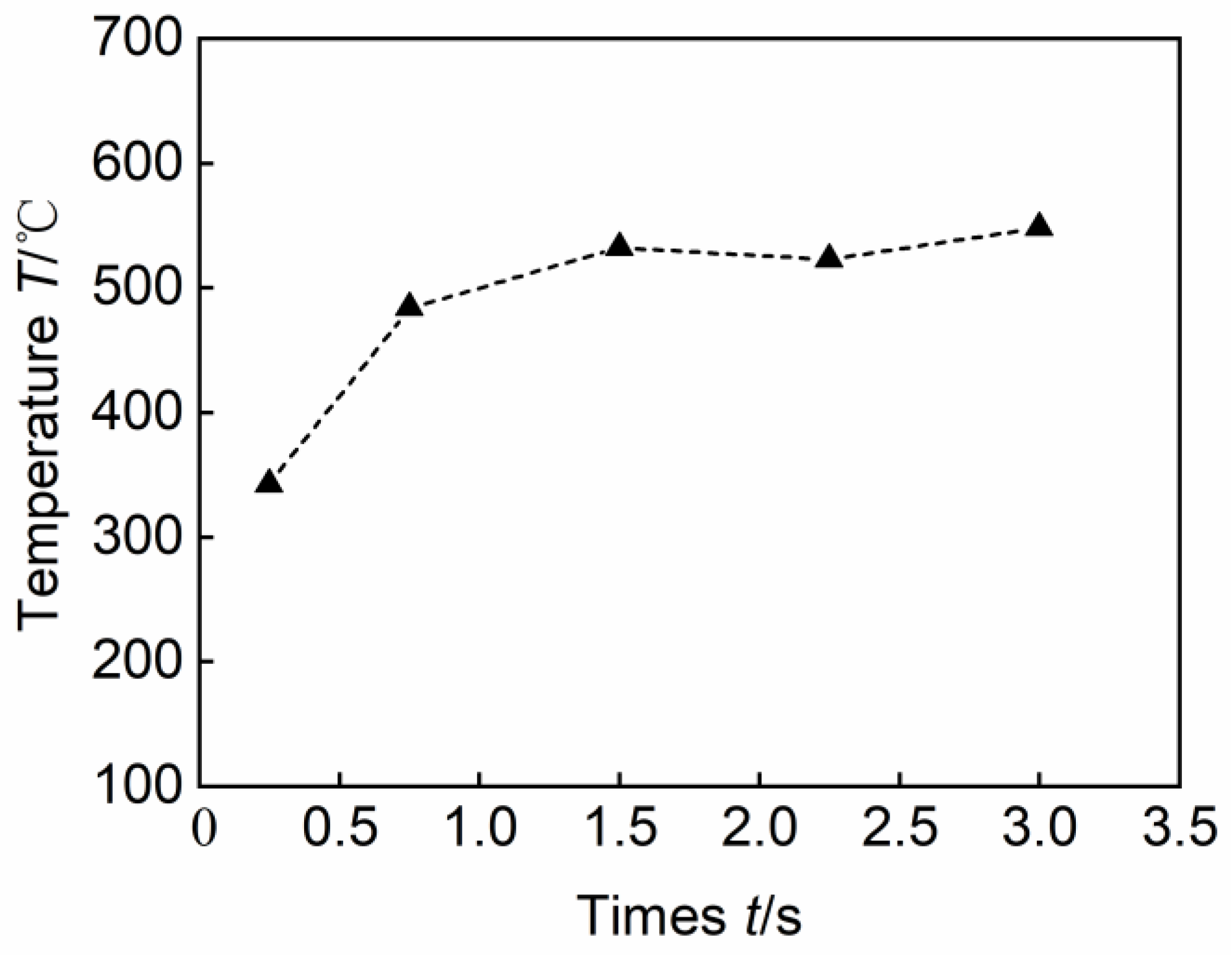
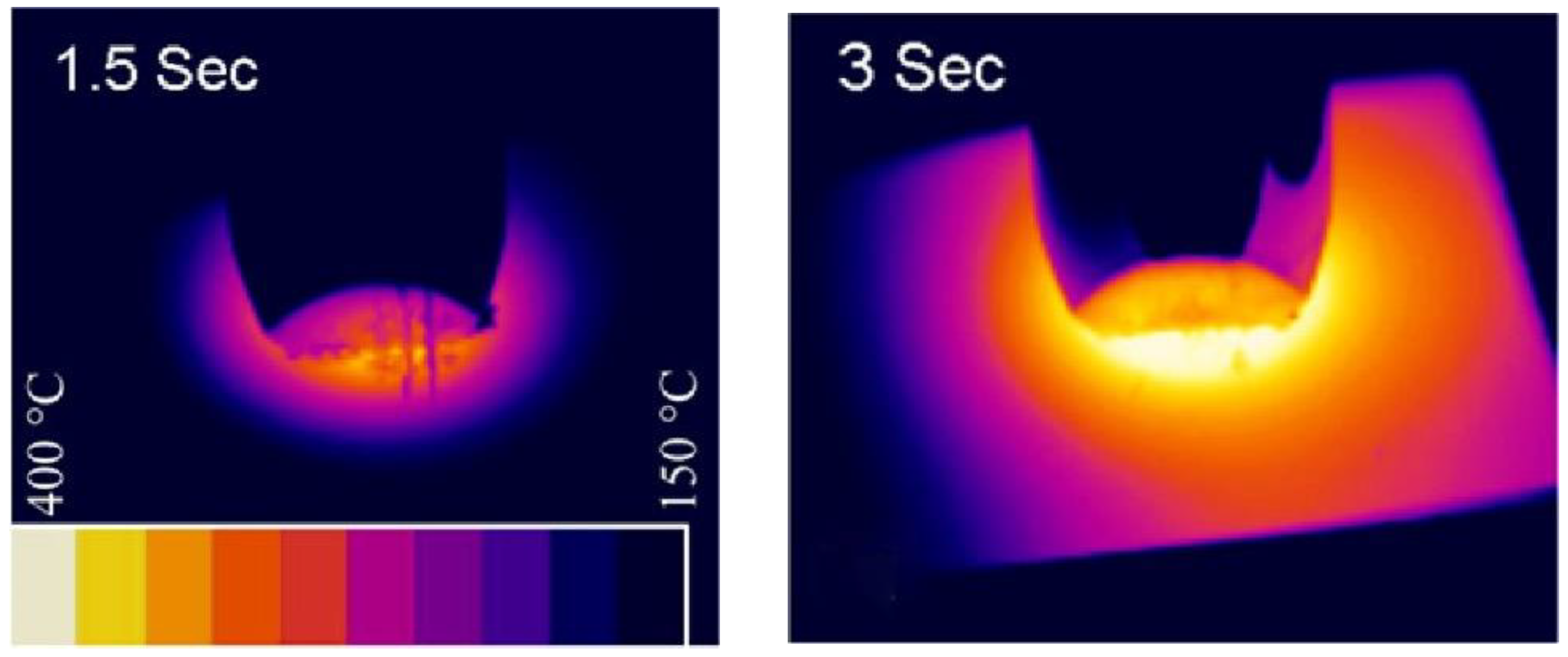
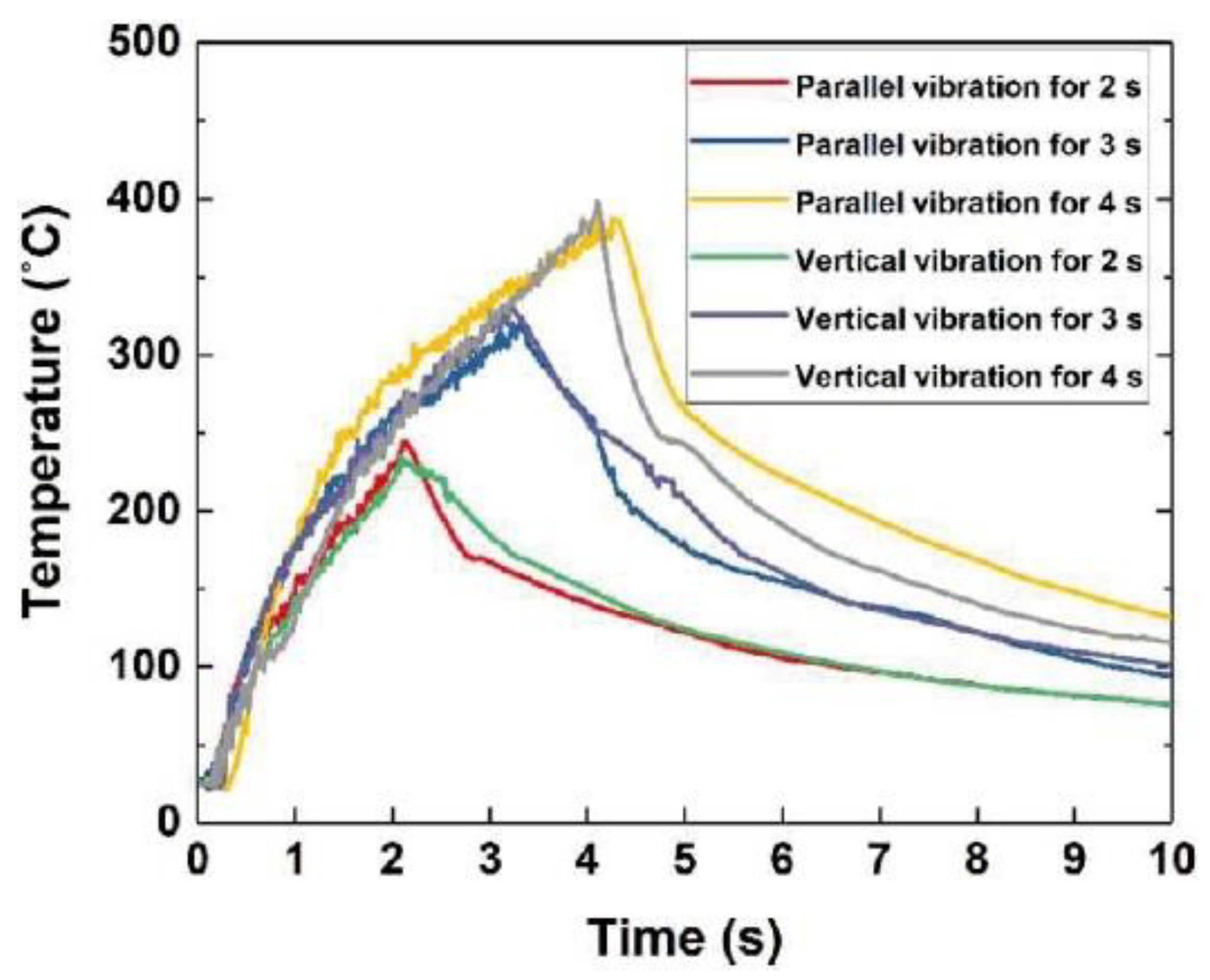


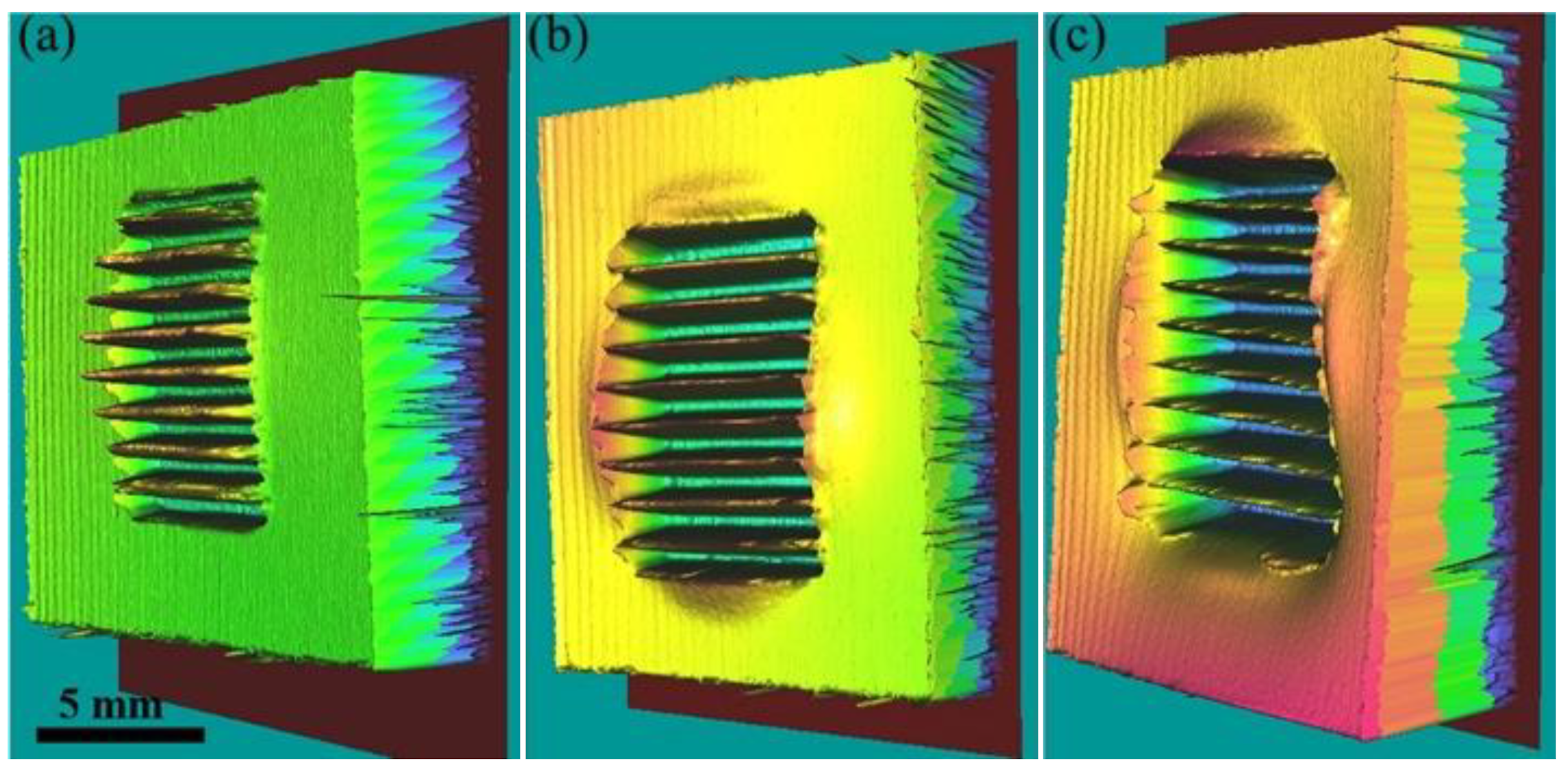
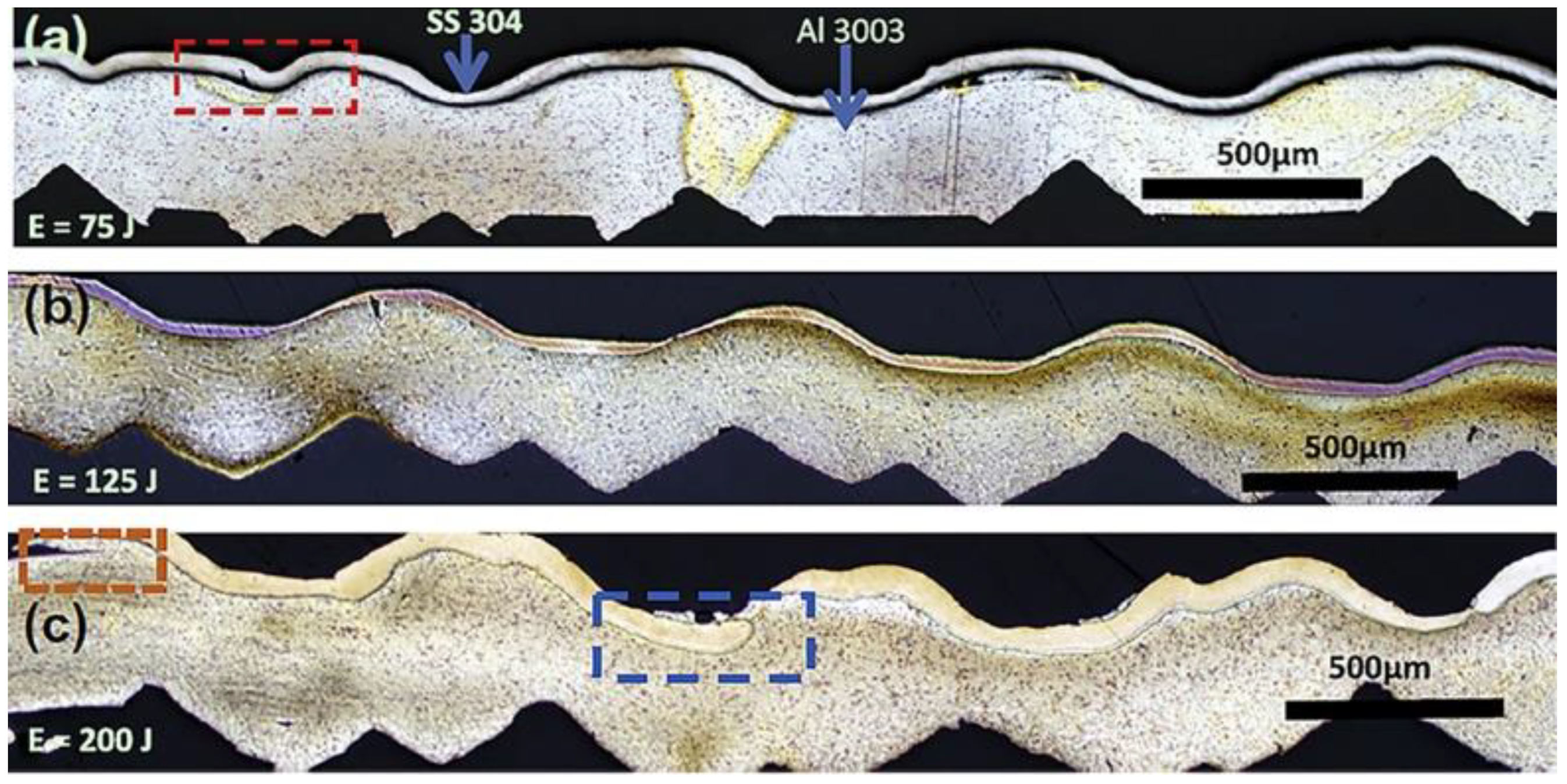

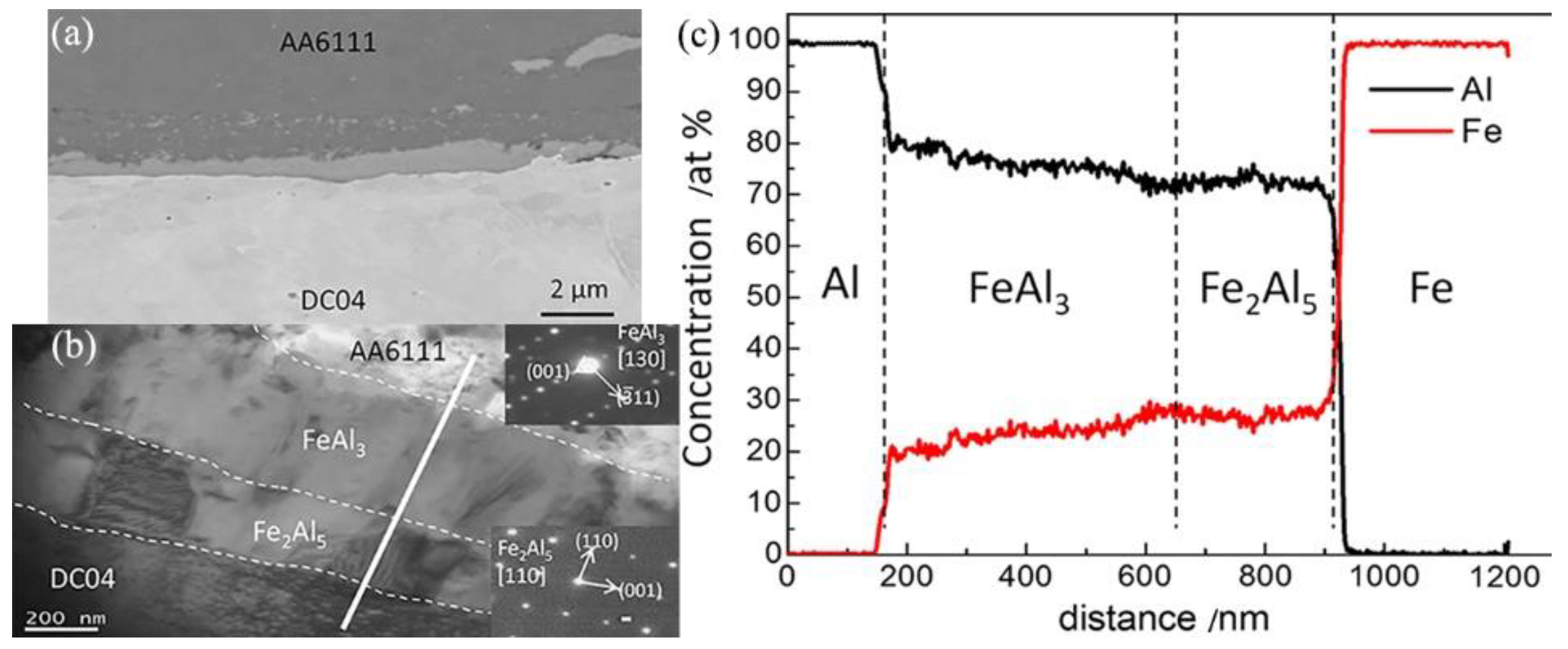
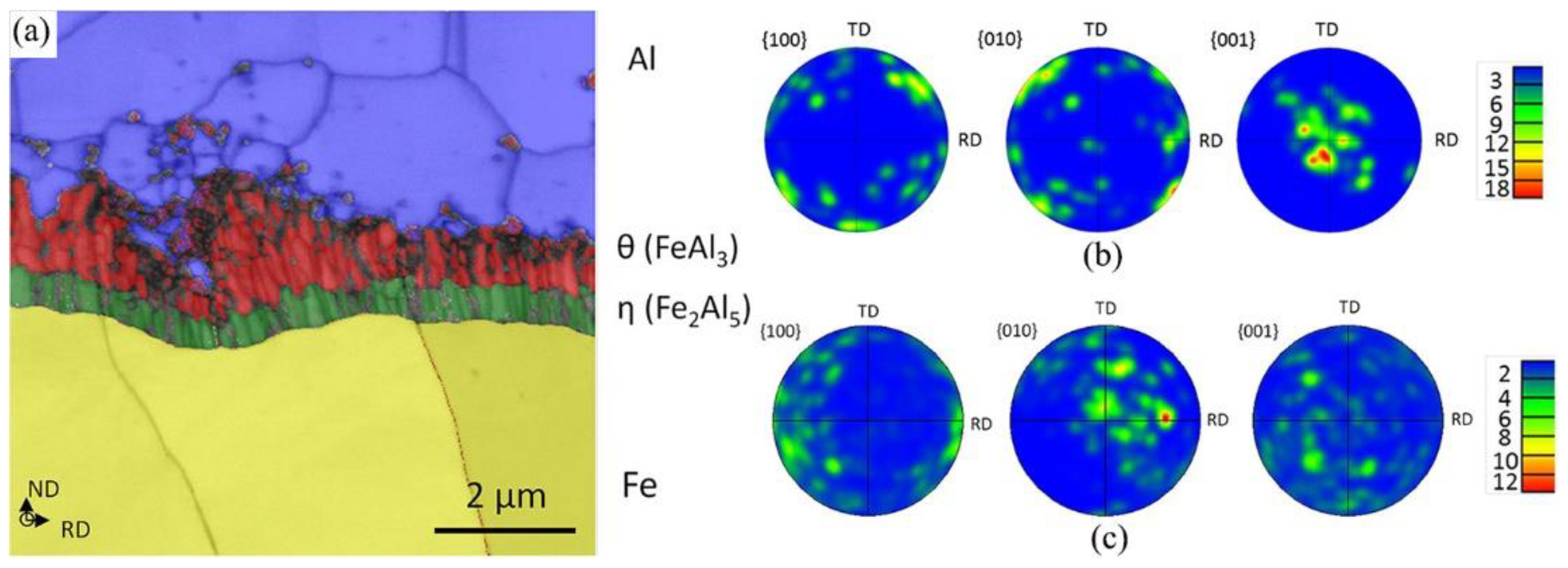
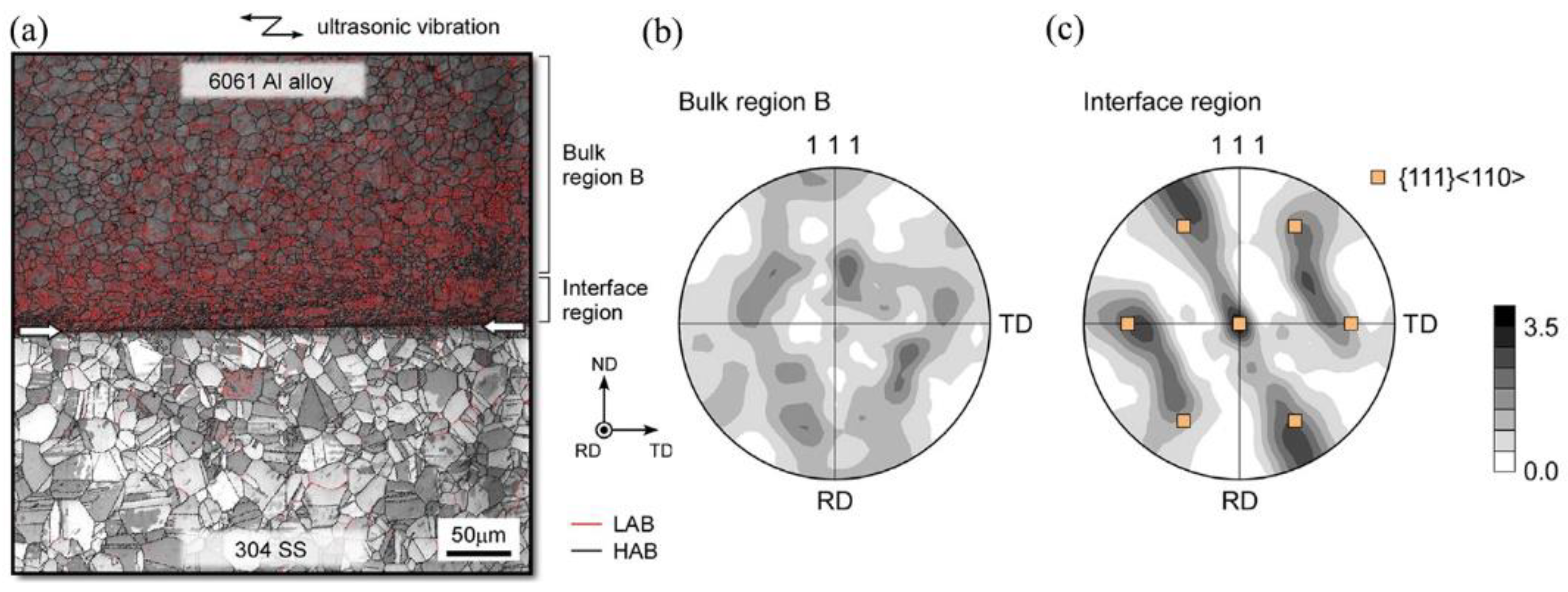
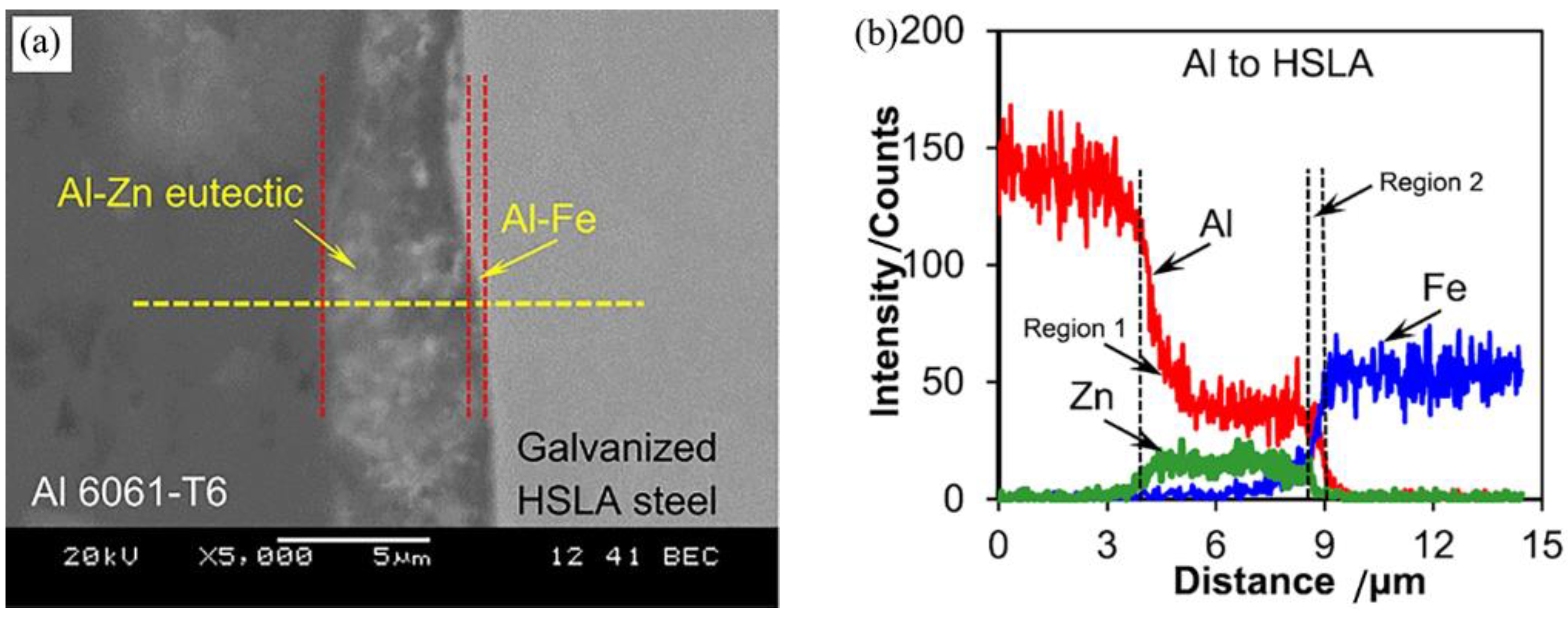




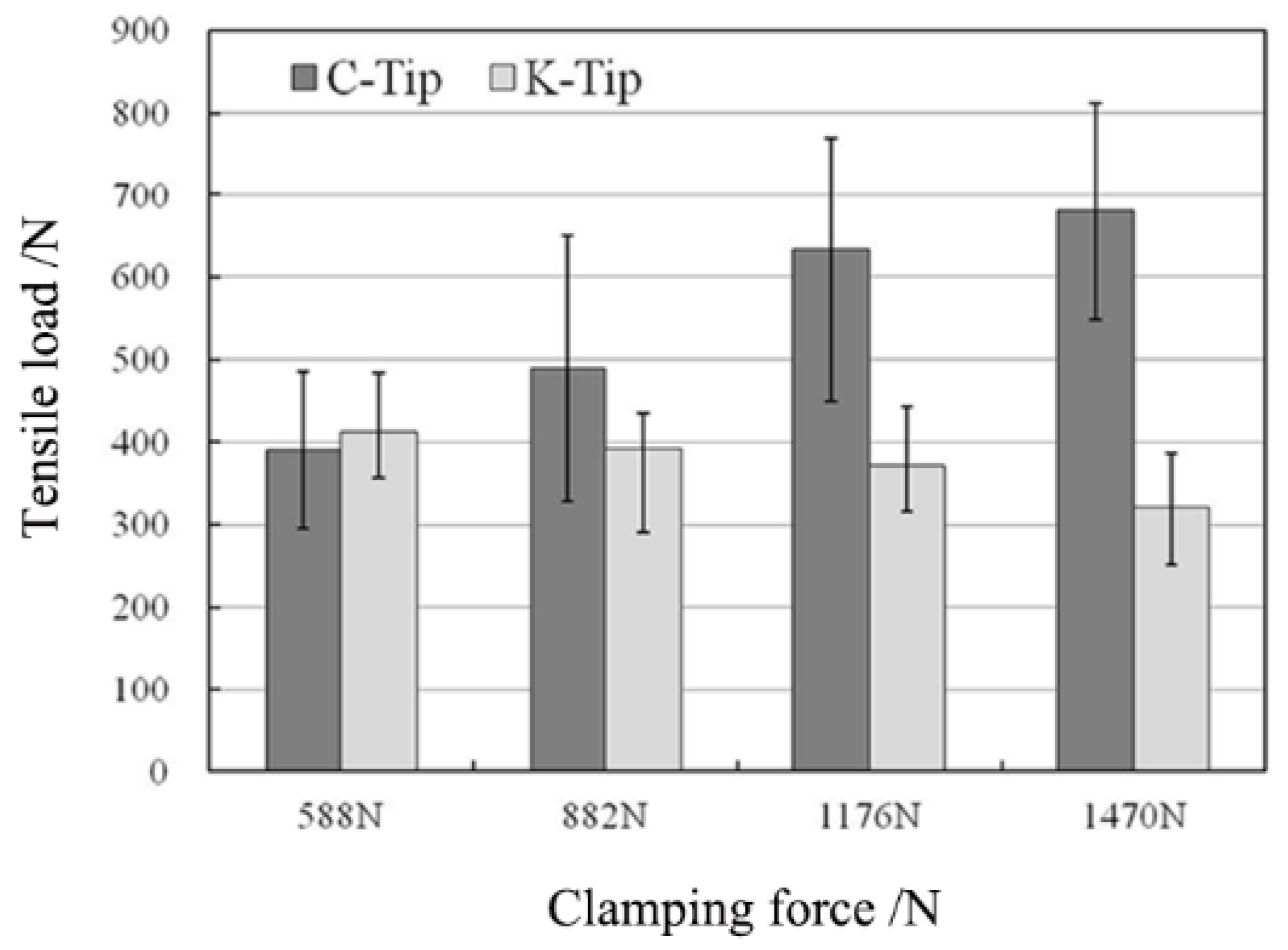









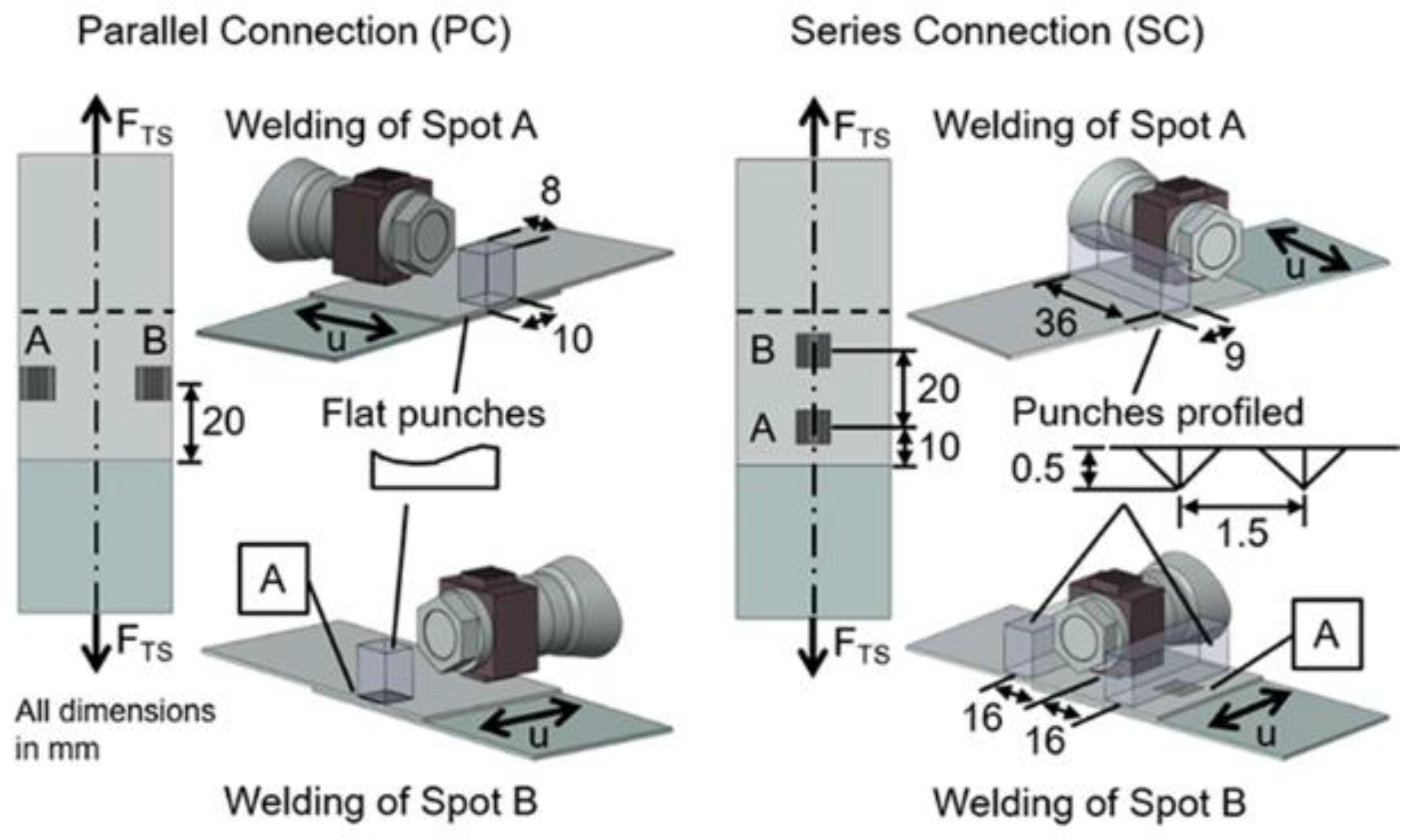
| Base Metal | Welderpower | Welding Parameters | Weld Strength | Failure Mode | Ref. | ||||
|---|---|---|---|---|---|---|---|---|---|
| Energy | Time | Force | Amplitude | Evaluation | Max Value | ||||
| 1.0 mm–Al 6111-T4 and DX56-ZF Steel | 2.5 kW | - | 1.0 s | 1.4 kN | - | Tensile-shear | 2.7 kN | Interface failure | [3] |
| 1.0 mm–Al 6111-T4 to DX53-ZF Steel | 2.5 kW | - | 3.0 s | 2.3 kN | - | Tensile-shear | 3.1 kN | Interface failure | [3] |
| 1.25 mm–Al 6111-T4 and 1.2 mm–HLSA Steel | 2.5 kW | 2000 J | - | 0.4 MPa | - | Tensile-shear | 4.3 kN | TTT | [5] |
| 1.0 mm–IF Steel and Al 5052 | 3.5 kW | - | 2.5 s | 1.5 kN | 41 μm | Tensile-shear | 1.6 kN | - | [21] |
| 0.6 mm Al A3003 and 0.1 mm–AISI 304 Steel | 3 kW | - | 0.35 s | 0.3 MPa | 68 μm | Tensile-shear | 9.5 kN | Nugget pull-out | [22] |
| 1.0 mm–Al 6111-T4 and DC04 Steel | 2.5 kW | - | 1.5 s | 1.4 kN | - | Tensile-shear | 2.7 kN | Nugget pull-out | [31] |
| 1.0 mm Al 6022-T4 and 1.2 mm–DP600 Steel | 0.8 kW | - | 3.0 s | 0.448 MPa | - | Tensile-shear | 2.9 kN | Interface failure | [34] |
| 0.5 mm–Al 5754 O and 0.8 mm–HSLA Steel | 2 kW | 2000 J | - | 0.414 MPa | - | Tensile-shear | 3.7 kN | Interface failure | [36] |
| 1.5 mm–Al 6061-T6 and HSLA Steel | 2 kW | 1750 J | - | 0.4 MPa | - | Tensile-shear | 2.76 kN | TTT | [38] |
| 1.5 mm–Al 6061-T6 and ASTM Steel | 2 kW | 1500 J | - | 0.4 MPa | - | Tensile-shear | 3.36 kN | TTT | [38] |
| 300 μm–Al 3003 and 50 μm–304 Steel | 2.4 kW | 225 J | - | 0.207 MPa | 58 μm | U-tensile | 0.375 kN | - | [40] |
| 1.2 mm–Al A5052-H24 and 1.2 mm–Al A1050-H24 and 0.8 mm–SS400 Steel | 2.4 kW | - | 3.0 s | 588 N | 53 μm | U-tensile | 1.8 kN | - | [41] |
| 0.93 mm–Al 6111-T4 and 1 mm–DC04 Steel | 2.5 kW | - | 1.5 s | 1.4 kN | - | Tensile-shear | 2.8 kN | Nugget pull-out | [42] |
| 1.5 mm–Al 6061-T6 and AISI 304 Steel | 2 kW | 750 J | - | 0.4 MPa | - | Tensile-shear | 3.5 kN | TTT | [43] |
| 1.5 mm–Al 6061-T6 and ASTM A36 Steel | 2 kW | 1500 J | - | 0.4 MPa | - | Tensile-shear | 3.3 kN | TTT | [43] |
| 1.0 mm–Al A6111 and DC04 Steel | 2.5 kW | - | 1.5 s | 1.4 kN | - | Tensile-shear | 3.2 kN | Interface failure | [44] |
| 1.0 mm–Al A7055 and DC04 Steel | 2.5 kW | - | 1.5 s | 1.4 kN | - | Tensile-shear | 3.1 kN | Interface failure | [44] |
| 1.0 mm–Al 6061-T6 and 0.5 mm–304 Steel | 0.9–1.06 kW | 1200 J | - | 0.3 MPa | 51 μm | Tensile-shear | 2.8 kN | Nugget pull-out | [45] |
| 0.9 mm–Al A6005A-T4 and 1.0 mm–HCT980X Steel | 4 kW | 2000 J | - | 1.485 kN | 22.5 μm | Tensile-shear | 4.353 kN | Interface failure | [46] |
| 1.0 mm–Al 6061-T6 and 1.5 mm–A36 Steel | 2.5 kW | - | 1.8 s | 0.35 MPa | 30 μm | Tensile-shear | 3.91 kN | Mixed failure | [48] |
| 1.2 mm–Al A5052-H24 and 0.5 mm–Al A1050 and 0.8 mm–SS400 Steel | 2.4 kW | - | 3.0 s | 0.588 kN | - | Tensile-shear | 1.15 kN | - | [49] |
| 0.7 mm–Al A1100 and 0.2 mm–AISI 304 Steel | 3 kW | - | 0.72 s | 0.32 MPa | 68 μm | T-peel | 217.1 N | Interface failure | [50] |
Disclaimer/Publisher’s Note: The statements, opinions and data contained in all publications are solely those of the individual author(s) and contributor(s) and not of MDPI and/or the editor(s). MDPI and/or the editor(s) disclaim responsibility for any injury to people or property resulting from any ideas, methods, instructions or products referred to in the content. |
© 2022 by the authors. Licensee MDPI, Basel, Switzerland. This article is an open access article distributed under the terms and conditions of the Creative Commons Attribution (CC BY) license (https://creativecommons.org/licenses/by/4.0/).
Share and Cite
Zhang, C.; Li, H.; Liu, Q.; Huang, C.; Zhou, K. Ultrasonic Welding of Aluminum to Steel: A Review. Metals 2023, 13, 29. https://doi.org/10.3390/met13010029
Zhang C, Li H, Liu Q, Huang C, Zhou K. Ultrasonic Welding of Aluminum to Steel: A Review. Metals. 2023; 13(1):29. https://doi.org/10.3390/met13010029
Chicago/Turabian StyleZhang, Changxin, Huan Li, Qianxi Liu, Chaowang Huang, and Kang Zhou. 2023. "Ultrasonic Welding of Aluminum to Steel: A Review" Metals 13, no. 1: 29. https://doi.org/10.3390/met13010029




